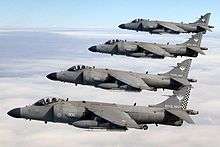Formation flying
Formation flying is the flight of multiple objects in coordination.

Migrating birds
Studies of birds have shown that the V formation can greatly enhance the overall aerodynamic efficiency by reducing the drag and thereby increasing the flight range.[1]
Military aviation

In military aviation, formation flying is the disciplined flight of two or more aircraft under the command of a flight leader.[2] Military pilots use formations for mutual defense and concentration of firepower.[3]
Unmanned aerial vehicle formation flight
The challenge of achieving safe formation flight by unmanned aerial vehicles has been extensively investigated in the 21st century with aircraft and spacecraft systems. For aerial vehicles the advantages of performing formation flight include fuel saving, improved efficiency in air traffic control and cooperative task allocation. For space vehicles precise control of formation flight may enable future large aperture space telescopes, variable baseline space interferometers, autonomous rendezvous and docking and robotic assembly of space structures.[4] One of the simplest formations used is where autonomous aircraft maintain formation with a lead aircraft which may itself be autonomous.[5]
Civil aviation

In civil aviation, Formation flying is proposed to reduce fuel use by minimizing drag.[6] Formation flying is performed at air shows or for recreation.
In the early 2000s, NASA’s Autonomous Formation Flight program used a pair of F/A-18s. In 2013, the Air Force Research Laboratory’s Surfing Aircraft Vortices for Energy project showed 10-15% in fuel savings, installed on two Boeing C-17 Globemaster IIIs. In 2017, NASA measured 8%-10% lower fuel flow with two Gulfstream III aircraft on wake surfing test flights. In 2018, the ecoDemonstrator, a Boeing 777F freighter from FedEx Express, had its fuel consumption reduced by 5-10% with the autopilot maintaining the 4,000 ft (1.2 km) separation based on ADS-B and TCAS information.[7]
By taking advantage of wake updraft like migrating birds (biomimicry), Airbus believes an aircraft can save 5-10% of fuel by flying 1.5–2 nmi (2.8–3.7 km) behind the preceding one. After A380s tests showing 12% savings, it launched its 'fello'fly' project in November 2019 for test flights in 2020 with two A350s, before transatlantic flight trials with airlines in 2021. Certification for shorter separation is enabled by ADS-B in oceanic airspace, and the only modification required would be flight control systems software. Comfort would not be affected and trials are limited to two aircraft to reduce complexity but the concept could be expanded to include more. Commercial operations could begin in 2025 with airline schedule adjustments, and other manufacturers’ aircraft could be included.[8]
References
| Wikimedia Commons has media related to Aircraft formation flight. |
- "Effects of Leader’s Position and Shape on Aerodynamic Performances of V Flight Formation"
- T-34 Association Formation Flight Manual
- Pilot's Manual for Basic Flying Training, Royal Canadian Air Force TC-44, 1962
- Gu, Yu; et al. (2011). "Formation Flight Control". International Journal of Aerospace Engineering. 2011: 1–2. doi:10.1155/2011/798981.
- "3 YF-22 UAV Formation Flight Control Experiment". 2004.
- Kroo, Ilan. "Future Air Transportation and the Environment". Woods Energy Seminar. Stanford University. Retrieved 13 March 2011.
- Guy Norris (Dec 10, 2019). "Boeing, FedEx 777F Tests Confirm Wake Fuel Burn Benefit". Aviation Week Network.
- Jens Flottau (Nov 18, 2019). "Airbus Seeks Up To 10% Fuel Burn Savings By Aircraft Flying Together". Aviation Week Network.